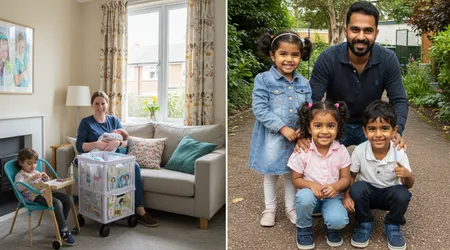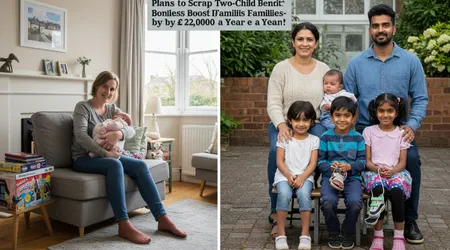Plans to Scrap Two-Child Benefit Cap Could Boost Jobless Families by £20,000 a Year

Plans to Scrap Two-Child Benefit Cap could transform the lives of jobless families, offering up to £20,000 annually in financial relief.
Introduced in 2017 by the Conservative government, this policy limits Universal Credit and Child Tax Credit to only the first two children in most households, leaving larger families struggling.
As child poverty soars reaching 4.45 million children in 2024, per the Department for Work and Pensions the Labour government’s potential decision to abolish this cap signals hope.
This article explores the policy’s impact, the case for its removal, and what it means for families and society. Why should we care about a system that penalises children for being born third?
The Two-Child Benefit Cap: A Policy Under Fire
The two-child benefit cap, launched under austerity measures, restricts support for third or subsequent children born after April 2017.
It affects 1.6 million children, with 59% of impacted households working, according to 2024 parliamentary data. Critics argue it deepens poverty without achieving its aim of discouraging larger families.
Charities like Save the Children call it “vicious,” noting its failure to boost employment. Instead, it traps families like Sarah’s, a single mother of three in Manchester, who skips meals to afford school uniforms.
Scrapping the cap could lift 470,000 children out of poverty, says the Resolution Foundation. Yet, the cost estimated at £3.5 billion annually sparks debate.
++ What to Expect from the DWP in the Autumn Budget 2025
Supporters argue it’s an investment, as child poverty costs the UK £39 billion yearly in public services. For families, the cap’s removal could mean £3,455 per additional child annually, transforming their financial stability.
The policy’s cruelty lies in its arbitrary nature. Why should a third child receive less support than their siblings? It’s a question that haunts campaigners.
The cap’s exceptions, like for children born from non-consensual conception, highlight its moral complexity. Public sentiment, with 73% supporting family aid per Save the Children’s 2025 survey, pushes Labour to act.

Economic and Social Stakes of Scrapping the Cap
Removing the Plans to Scrap Two-Child Benefit Cap could reshape household budgets. For a family with five children, the gain could exceed £20,000 yearly, per 2025 government figures.
This isn’t just money it’s food, heating, and school trips. Take the Wilsons, a jobless family of six in Birmingham: the cap cuts their income by £6,910 annually, forcing reliance on food banks.
| Household Size | Additional Annual Benefit if Cap Scrapped | Children Lifted from Poverty |
|---|---|---|
| 3 children | £3,455 | 250,000 |
| 4 children | £6,910 | 350,000 |
| 5+ children | £10,365+ | 470,000 |
The economic ripple effect is profound. Reducing poverty cuts healthcare and social service costs, potentially saving billions.
However, critics like Conservative MP Helen Whately argue it’s unfair to taxpayers, equating benefits to minimum-wage earnings.
Yet, the cap’s defenders overlook its failure to incentivise work, as 59% of affected families are employed.
Labour’s hesitation stems from fiscal constraints, with Chancellor Rachel Reeves facing a £50 billion budget shortfall. Still, scrapping the cap is cost-effective compared to other poverty alleviation measures.
The societal cost of inaction rising crime, lower productivity far outweighs the upfront expense, making the cap’s removal a pragmatic choice.
Also read: How to Link Your Benefits to NHS Prescription Discounts
Political Dynamics and Public Pressure
The Plans to Scrap Two-Child Benefit Cap face political headwinds. Labour’s internal divide is stark: seven MPs were suspended in 2024 for supporting an SNP motion to abolish it.
Keir Starmer, once opposed due to costs, now reportedly backs scrapping it, per The Observer’s May 2025 report. Education Secretary Bridget Phillipson’s hint at “considering” the move reflects shifting tides.
Public pressure is mounting. Charities like the Child Poverty Action Group highlight that 109 children fall into poverty daily due to the cap.
Scotland’s pledge to mitigate the cap by 2026 challenges Westminster to follow. Even Nigel Farage’s Reform UK supports scrapping it, isolating Conservative defenders like Kemi Badenoch, who call it unaffordable.
Read more: What Happens During a DWP Compliance Interview?
Voters, especially Labour’s base, demand action. A 2025 survey showed 76% of Labour-to-Reform switchers want poverty tackled.
This isn’t just politics it’s about families like the Khans in Leeds, whose third child’s exclusion from benefits means choosing between rent and groceries. The cap’s days seem numbered as public and political momentum aligns.
Labour’s Child Poverty Taskforce, delayed until autumn 2025, is pivotal. Aligning its strategy with the budget suggests a funded plan to scrap the cap.
Gordon Brown’s advocacy, calling it “cruel,” adds weight. The taskforce must balance fiscal rules with moral imperatives, ensuring no family is left behind.
A Moral and Practical Case for Change
Imagine a bridge collapsing under the weight of neglect child poverty is that bridge, and the cap is a deliberate crack. The Plans to Scrap Two-Child Benefit Cap offer a repair.
Beyond economics, it’s about dignity. Families shouldn’t face judgment for their size, yet the cap punishes third children, branding them less deserving.
Charities argue scrapping it is the most effective poverty reduction tool. The Joseph Rowntree Foundation notes it could alleviate homelessness in Scotland, where 15,000 children are affected.
In England, councils like Oldham report 11,340 children hit by the cap, with 27,760 in poverty. Scrapping it could transform local economies.
The moral argument is unassailable. A society that lets 4.45 million children live in poverty per 2024 DWP data fails its future. Scrapping the cap isn’t charity; it’s justice.
It ensures kids like Sarah’s youngest can eat without their mother’s sacrifice. Labour must act to restore fairness.
Yet, the practical side demands scrutiny. Funding requires bold choices raising gambling levies, as Gordon Brown suggests, or reallocating welfare budgets.
The alternative is grim: child poverty could hit 4.8 million by 2029, per the Resolution Foundation. The cap’s removal is a step toward a fairer, richer UK.
The Broader Impact on Society

The Plans to Scrap Two-Child Benefit Cap extend beyond individual families. Child poverty fuels crime, poor health, and low educational attainment, costing £39 billion annually, per the Child Poverty Action Group.
Lifting 470,000 children out of poverty could reduce these burdens, boosting national productivity.
Consider the ripple effect: healthier kids mean fewer NHS visits; better-educated children drive economic growth. The cap’s removal could break cycles of deprivation.
For instance, a family in poverty might skip extracurricular activities, limiting a child’s potential. Extra income could fund music lessons, sparking a future career.
Skeptics argue it encourages dependency, but evidence disagrees. The cap hasn’t reduced birth rates or boosted employment, per University of York research. Instead, it entrenches hardship.
Scrapping it aligns with public will 73% support family aid, per Save the Children’s 2025 poll making it a societal win.
The policy’s abolition could also ease local government strain. Councils spend millions on poverty-related services, from housing to social care.
By lifting families out of poverty, the Plans to Scrap Two-Child Benefit Cap could free up resources for schools and community projects, fostering a stronger society.
Conclusion: A Defining Moment for Labour
The Plans to Scrap Two-Child Benefit Cap represent a crossroads for Labour. With 4.45 million children in poverty and public support surging, scrapping the cap is both a moral and economic necessity.
It’s a chance to restore fairness, ensuring no child is penalised for their birth order. Labour’s Child Poverty Taskforce, set to report in autumn 2025, must deliver bold action, not half-measures.
This isn’t just about £20,000 for families like Sarah’s or the Wilsons’. It’s about a society that values every child equally. The cost £3.5 billion is dwarfed by the £39 billion price of inaction.
Labour can redefine its legacy by choosing justice over austerity. Will they seize this moment to build a fairer UK?
Frequently Asked Questions
What is the two-child benefit cap?
It’s a 2017 Conservative policy limiting Universal Credit and Child Tax Credit to the first two children in most households, affecting 1.6 million kids.
How much could families gain if the cap is scrapped?
Families with five or more children could gain over £20,000 annually, with £3,455 per additional child, per 2025 government figures.
Why is the cap controversial?
It pushes 109 children into poverty daily, per the Child Poverty Action Group, without boosting employment or reducing birth rates, deepening hardship.
When might Labour scrap the cap?
The Child Poverty Taskforce’s strategy, due in autumn 2025, may include plans to abolish it, aligned with the budget, per The Observer.
Who supports scrapping the cap?
Charities, Labour MPs, the SNP, Liberal Democrats, and even Reform UK’s Nigel Farage back its removal, citing its cruelty and ineffectiveness.
